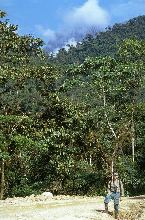 Here is a photo of me in Peru. I am standing on a road, and
just behind me you can see the rainforest. But above the
rainforest, slightly hidden by the clouds, you can see some
peaks of the Andes poking through.
Here is a photo of me in Peru. I am standing on a road, and
just behind me you can see the rainforest. But above the
rainforest, slightly hidden by the clouds, you can see some
peaks of the Andes poking through.
 Here is a photo of me in Peru. I am standing on a road, and
just behind me you can see the rainforest. But above the
rainforest, slightly hidden by the clouds, you can see some
peaks of the Andes poking through.
Here is a photo of me in Peru. I am standing on a road, and
just behind me you can see the rainforest. But above the
rainforest, slightly hidden by the clouds, you can see some
peaks of the Andes poking through.
You can click on almost any photo to see a larger version. This
one, in particular, looks much better in the full view.
Finally, with his final wingbeat he hit the edge of the net, got tangled, and twisted around so that he was essentially in a bag of delicate netting, and it became clear that we would have to extract that beak and set of talons (and the bird attached to them) from the mist net.
I had removed lots of feisty birds from mist nets before, but they had all been little, and the worst they could do was to give me a good solid pinch. The hawk looked like he could do a lot more damage than that ...
I had finally talked my wife Ellyn into participating on an Earthwatch expedition, and we were in Manu National Park in Peru, volunteering our labor on a hummingbird research project. We were trying to capture as many hummingbirds as possible so their flight characteristics could be tested, but there's no such thing as a net that catches only hummers -- we spent perhaps two-thirds of our time extracting other birds and freeing them.
The Earthwatch organization connects volunteers with scientific researchers who are in need of semi-skilled but usually enthusiastic volunteers. I had done four Earthwatch trips previously -- two involving bird netting and banding in Ecuador, one studying a certain genus (Heleconius) of butterflies also in Ecuador, and finally a caterpillar research project in Costa Rica.
We were introducted to Earthwatch by our friend Muriel whom we met in the Galápagos Islands many years ago. She is an Earthwatch junkie, and helped me talk Ellyn into her first Earthwatch trip and Muriel's twenty-second. Muriel had been to Peru on a birding trip the previous year and had scoped out all the sites for the hummingbird project, and determined that the third trip was the best one -- best birds, best location, best climate, and so on. We hadn't seen Muriel for years and were looking forward to working with her.
Doug had selected a number of research sites along a sort of transect that goes roughly along the Cusco-Manu road ranging in elevation from nearly sea-level in the Amazon basin to about 3800 meters. At each site he'd capture hummers, test them and release them, and he needed lots of volunteers to help. I think Muriel selected our site (which was at the Selva Sur Lodge at about 1400 meters) because it was high enough that it wouldn't get beastly hot, and low enough that we wouldn't be freezing our tails off at night high in the foggy, cold Andes.
Peru is a great country for this experiment since there are perhaps more species of hummingbird there than in any other country in the world, and Manu is a great place in Peru for the study since almost any of the possible hummingbird elevations can be sampled at some point along the Cusco-Manu road.
The drill at each of his sites was similar, however. A series of mist-nets is set up in likely spots to capture hummingbirds, and the nets are checked frequently for captured birds. Anything other than a hummingbird is released, and the hummers are returned in small cloth bags to the lab.
In the lab is a box with a square base that's about a half-meter on a side, and is about a meter high. Its walls are nylon mesh, and it has a plexiglass top. A mirror placed at 45 degrees to the top allows a video camera to view the flight from the top, while a second, synchronized camera gets a side view. These two cameras record the wing motions during the flight tests.
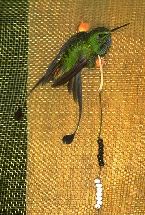 Each hummingbird is filmed in two ways -- once during normal
flight, and once wearing the "necklace". The necklace is a
small rubber-band around the bird's neck connected to a thread
on which are mounted a series of equally-spaced weights. The
hummingbird trys to escape by flying straight up, and the higher
it goes, the more weights are lifted off the bottom of the box.
The camera with the side view records the maximum number of
weights lifted and this gives a pretty good measure of the
maximum power that the bird's wings can provide for lifting.
In additon, since there's also a top and side view, the wing
motions the bird uses to generate the various amounts of power
can be analyzed.
Each hummingbird is filmed in two ways -- once during normal
flight, and once wearing the "necklace". The necklace is a
small rubber-band around the bird's neck connected to a thread
on which are mounted a series of equally-spaced weights. The
hummingbird trys to escape by flying straight up, and the higher
it goes, the more weights are lifted off the bottom of the box.
The camera with the side view records the maximum number of
weights lifted and this gives a pretty good measure of the
maximum power that the bird's wings can provide for lifting.
In additon, since there's also a top and side view, the wing
motions the bird uses to generate the various amounts of power
can be analyzed.
On the left is a photo of a Booted Raquet-tail being "flight-tested". You can see the rubber-band necklace trailing a chain of beads. In this photo, the hummingbird has stopped flying and is perched on the wall of the flight chamber.
After the flight tests, a whole series of morphological measurements are made -- mass, wing measurements, beak measurements, et cetera, and finally, a tiny drop of blood is taken for later DNA analysis to help generate a phylogenetic evolutionary tree for the hummingbirds in the area. Then the bird is released.
Another project involved making observational notes on the behavior of hummingbirds -- which ones chase off others, which ones guard a food supply and which ones move from supply to supply, how often they feed, what kind of flowers they feed on, et cetera. These were usually done by teams of two people with a bunch of stop-watches and a notebook, and were done in one hour chunks.
I found the observations tedious and much preferred the action at the nets, so I only put in four observation hours during the entire two weeks of the project and except for the day I spent helping out in the lab with flight measurements, I spent the rest of my time on the net detail. Luckily for Doug, there were enough people who liked observation better than net detail that he got a nice collection of observations.
The mist nets are reasonably delicate, and it's not hard to accidentally break a few threads if you snag the net with a stick or your backpack. They're also not cheap -- around $120 each -- and apparently at the first of Doug's sites a volunteer decided he was too lazy to untangle branches that got snagged and he just ripped them out, basically single-handedly destroying 3 of the nets. We had about 18 of them left.
 If you're setting up a net by the side of the road it's pretty
straight-forward and takes perhaps 15 minutes for two people to
set one up. The photo on the left shows Chris (one of the
staff members) and my wife Ellyn setting up a net.
The net poles were just PVC pipe in two sections,
and we would push or pound a piece of iron rebar into the ground
that the poles slipped over. Another piece of rebar (or a tree
or rock) would serve as an anchor. If you were in the forest,
setting up a net could be a lot tricker since you had to find
a relatively open straight stretch more than 9 or 12 meters
long, and you often had a lot of hacking to do with a machete
to clear out vines and branches that might tangle the net.
If you're setting up a net by the side of the road it's pretty
straight-forward and takes perhaps 15 minutes for two people to
set one up. The photo on the left shows Chris (one of the
staff members) and my wife Ellyn setting up a net.
The net poles were just PVC pipe in two sections,
and we would push or pound a piece of iron rebar into the ground
that the poles slipped over. Another piece of rebar (or a tree
or rock) would serve as an anchor. If you were in the forest,
setting up a net could be a lot tricker since you had to find
a relatively open straight stretch more than 9 or 12 meters
long, and you often had a lot of hacking to do with a machete
to clear out vines and branches that might tangle the net.
After the nets were set up, they would be opened and closed each day, and while they were open, we tried to visit them fairly frequently since you don't want to leave a bird hanging in the net for too long -- especially if it's hot or raining. At the end of the day we'd close the nets by rolling them up while still attached to the poles. It takes four or five minutes to open or close a net.
The first day the nets are up, you usually catch a lot, but the number goes down pretty drastically over the next two or three days, so you're constantly moving the nets. It's quite a juggling act -- you're moving nets while there are others open, which still have to be visited regularly. Getting the birds untangled from the nets is also not trivial, so when we started, Doug also wanted to make sure that one of his experienced assistants was available for untangling help as well.
The main problem with Earthwatch trips (from the point of view of the PI, at least) is that in two weeks you get your crew of volunteers pretty well trained, but then they leave to go home, and you're faced with a whole new crew of beginners. It's great for the volunteers -- you learn some interesting new skill, and then you get to leave before you get bored doing it. The net work was pretty chaotic at first, but the final three or four days went pretty smoothly. And Doug was lucky in that three of us volunteers actually had some previous experience with mist nets which probably allowed him to run a few more nets early on that he would have been able to do otherwise.
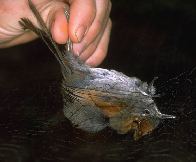
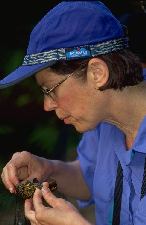 I've described elsewhere the Zen-like aspects of untangling birds
so I won't do it again here. Suffice it to say that the better
your concentration, the better you'll do. I'm pretty good at that,
but I even surprised myself a little when, after extracting a bird,
someone asked me what kind of bird it was. I hadn't the faintest
idea -- I was looking only at the net and the tangle and my brain
had shut out every other detail.
I've described elsewhere the Zen-like aspects of untangling birds
so I won't do it again here. Suffice it to say that the better
your concentration, the better you'll do. I'm pretty good at that,
but I even surprised myself a little when, after extracting a bird,
someone asked me what kind of bird it was. I hadn't the faintest
idea -- I was looking only at the net and the tangle and my brain
had shut out every other detail.
On the left is a photo of a bird tangled in the net, and the
extraction is just beginning. Typically, the head goes in first
and the feet last, so to untangle it, you reverse the operation. In
this photo, the feet have been untangled. In the photo on the
right is Ellyn working on a bird. Sometimes it is hard to see the
net, since it's under the feathers, so you can blow on the feathers
to expose the threads of the net. That's what Ellyn is doing
here.
In addition, two other volunteers joined us who had signed up too late to get on the official volunteer list -- Charlie and Marie.
The staff consisted of Doug (the PI), Chris (a friend Doug had gone to college with who was quite good with the mist nets), Michael (a student from the University of Texas who had just graduated and was planning to go to graduate school at the University of Washington in the fall), Alexa (a student between her junior and senior years at Middlebury College), and Wily (a Peruvian from Cusco).
 On the left is a photo of our group (you can click on it to get
a larger image). On the left is the staff guy (whose name I
forget), and his head is blocking Wily's. Then moving right from
Wily's blocked head in the back row is Michael, Chris, Doug, Jim,
John, yours truly, Marie, and Charlie. In the front row from
left to right are Muriel, Ellyn, Alexa, and Chiyo.
On the left is a photo of our group (you can click on it to get
a larger image). On the left is the staff guy (whose name I
forget), and his head is blocking Wily's. Then moving right from
Wily's blocked head in the back row is Michael, Chris, Doug, Jim,
John, yours truly, Marie, and Charlie. In the front row from
left to right are Muriel, Ellyn, Alexa, and Chiyo.
Michael had a lot of general knowledge about biology and it seemed
like he had a lot of field experience, especially for someone who had
just finished college. He spent most of his time with Doug in the lab
working on the hummingbirds that came in, although he also helped with
the mist nets from time to time. Alexa was going to concentrate on
the hummingbird flowers, measuring the nectar supply, finding out how
common the flowers were, et cetera. Wily was an expert on botany;
specifically trees of Manu, and the plan was that he should work with
Alexa to help her with the identifications. In practice, he probably
spent most of his time helping with the mist nets.
Among the volunteers, Muriel was of course the super-star in terms of Earthwatch experience, and she also knows a heck of a lot about birds. She had mist netting experience, but had hurt a knee before the trip while jogging, so was not able to help on the nets as much as she (and we) would have liked. Charlie and John were both very serious birders, but with different approaches. Charlie had done one Earthwatch trip earlier, and John had done about 5. Marie was new to birding and Earthwatch, and Jim was a photography nut who knew something about birds and a lot about hummingbirds. Chiyo had done one Earthwatch trip earlier and didn't know much about birds. In terms of bird knowledge, Ellyn and I ranked above Chiyo and Marie and except for hummingbirds probably knew as much as Jim.
Jim was nice enough to let me include some of his photos on this web page. Here they are.
But everyone else worked out fine. John, in particular, was great. If I ever get hooked on birding I hope I turn out exactly like him. I don't think he even keeps a list of the birds he's seen, but rather a notebook with his observations listed.
Chris had hurt his knee in a soccer game a few days previously, and it was really bugging him, so he planned to go to a hospital to get an X-ray and join us later, but Ellyn was able to examine it and determined that it probably wasn't serious, and would get better with just rest. Chris limped around a bit for the first couple of days, but luckily Ellyn was right and he seemed almost completely back to normal by the end of the trip. It's a good thing, too. It would have been tough to handle all the nets without him.
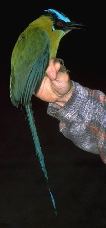 We then got in a bus and took off for Manu along the Cusco-Manu
road -- an eight-hour ordeal. The vast majority of the road
is dirt, one lane, and has an amazing drop-off on one side. The
route is liberally sprinkled with crosses, each of which
commemerates a spot where somebody went over the edge.
We then got in a bus and took off for Manu along the Cusco-Manu
road -- an eight-hour ordeal. The vast majority of the road
is dirt, one lane, and has an amazing drop-off on one side. The
route is liberally sprinkled with crosses, each of which
commemerates a spot where somebody went over the edge.
On the left is a photo of a Motmot -- a type of bird that we caught regularly in the nets, but the motmot is one of the first "interesting" birds I was able to see from the bus window after we entered Manu National Park.
On Mondays, Wednesdays, and Fridays the road is one-way going from Cusco toward Manu and on Tuesdays, Thursdays, and Saturdays, it is one-way in the other direction. On Sunday it's a free-for-all. Or at least that's the theory. There are plenty of cheaters, and you never know when you're going to come around a tight corner and be face-to-face with another giant bus or truck. Unless it's Sunday, the cheater is usually obliged to back up until a spot can be found for passing, but on Sunday every encounter can provide a great opportunity for discussion. But there are always the drivers who insist that since they started before midnight in the correct direction they have the right-of-way for the entire eight hours that the trip requires.
Many of the turns are so tight that a bus or truck can't make them without a couple of back-up maneuvers, and on one such turn Muriel cheerfully commented, "Oops! We almost hit the guard-rail." I don't think there are any guard-rails in the entire country of Peru.
But because you're almost always driving along the side of a cliff, you get some pretty good views -- sometimes you can see almost all the way to the Amazon, and sometimes you got views of 6500 meter peaks covered in snow. The road went over a couple of passes as high as 3800 meters before it began its long and twisting descent toward the Amazon and Manu.
It started to rain just as we entered the park, and for the next couple of hours as we approached the lodge it kept getting darker and wetter. We finally arrived at about 5:00 pm.
 On the left is a photo of some clearwing butterflies that I took
on my day off. The wings of all butterflies are clear, and all
the color comes from the scales (the powder) on the wings. These
clearwinged butterflies just never have any scales on parts of the
wings, so they are transparent. In the photo, notice that you can
see the bodies of the butterflies through portions of the wings.
On the left is a photo of some clearwing butterflies that I took
on my day off. The wings of all butterflies are clear, and all
the color comes from the scales (the powder) on the wings. These
clearwinged butterflies just never have any scales on parts of the
wings, so they are transparent. In the photo, notice that you can
see the bodies of the butterflies through portions of the wings.
The first and second net passes were always the most productive in terms of birds, so I always tried to go on those. Even on my days for observation and labs I usually went out on the opening run. When the nets were primarily set up on the road it was easy -- a fairly level walking surface, and you only needed the flashlight when you were trying to open the nets, but when the nets were primarily in the forest, walking was a lot more interesting -- steep, muddy trails with rocks and branches all along the way.
For the first few days the nets were set up on the road near the lodge, and it was pretty easy to service them. We could complete an entire cycle in about 15 minutes. Then we added some nets in the forest and the total time went up to about 25 minutes per pass. When all the nets were in the forest, it took a half hour, and later when we moved the nets back to the road, but much further from the lodge, the loop took 40 minutes. All these times, of course, assume that there were no birds to untangle. A nasty tangle might take 10 or 15 minutes to undo, although most birds came out in a minute or two.
Ideally, you'd like to visit the nets every half hour, so toward the end we weren't getting much rest, although we could sometimes have two teams alternating, but one day I did seven of the forty-minute passes and slept like a rock that night.
Hiking along the road wasn't too interesting, but I really enjoyed walking through the forest to service the nets. Unfortunately, the forest didn't yield too many hummingbirds, so the forest nets were only up for about three days. On the road, the route was an out-and-back, but in the forest you could do a loop. Even if there weren't any birds, on the forest loop you'd always see something -- weird plants, monkeys, weird insects, and even occasionally a mammal.
The folks who ran the lodge (a mother and son) spoke no English, and although they spoke Spanish, I think that the Incan language Quechua was their primary language. Michael spent a bit of time working with the son trying to learn a few phrases of Quechua and when he'd just ended a session with his tutor, I asked him if he were fluent yet.
He replied, "I think I'm in pretty good shape. I know how to say 'Hello, how are you?', and 'Kiss me on the lips', and I think that's all I need." Then suddenly he panicked, "Wait! Teacher! How do you say 'cerveza' (beer)?"
But about four days into the trip, we sat down to dinner and we each got a bowl of watery soup, and that was it. We were informed that they had run out of food which seemed very strange since they knew we were going to be there for two weeks, and they knew exactly how many of us there were.
The next morning all that was available was a couple of pieces of bread, so Doug insisted on getting on the radio to Cusco to get an emergency food delivery (that might take a couple of days because of the one-way-ness of the Cusco-Manu road). The lodge folks were talking to Cusco on the radio and said that the biologists "might like a little bit more food", and Doug blew up and demanded a lot more food.
Miraculously, there was a big lunch with no food deliveries, and a big dinner as well. The big meals continued with no food delivery. We were informed that the thin soup and bread were extra high quality and that was why there had been so little. Finally, they just said that the starvation rations were a "misunderstanding", and we never did figure out what went on. Food is subsidized and cheap (about 30 cents for a kilo of dry rice, for example), so by starving us they were probably only saving a few dollars each day for the entire group.
Every effort was made by the staff to save money. There was seldom enough toilet paper to make it through the night, and this was a real problem toward the end of the trip when we had a couple of cases of diarrhea. Similarly, there was a set-up for hot showers but the gas was turned on to heat it only when there were tourists at the lodge. The showers were pretty icy, so people smelled a bit worse than they could have.
There were tourists at the lodge for only a couple of nights during the trip, and the red carpet was pulled out for them -- there was hot water and they got much more interesting and substantial meals than we did. They were always served first and only when they were finished did the staff begin to think about the rest of us. It was a little annoying, but what was particularly annoying is after I got back I learned from Doug (who also learned after he returned) that we had paid exactly the same rate as the tourists had.
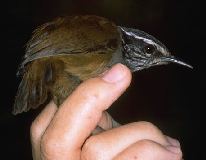
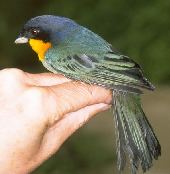
 In addition to the hummingbirds there were plenty of other
birds that we saw and accidentally captured in the mist nets. From
left to right is a Grey-breasted Wood-Wren, a Yellow-throated
tanager, and an Azara's Spinetail.
In addition to the hummingbirds there were plenty of other
birds that we saw and accidentally captured in the mist nets. From
left to right is a Grey-breasted Wood-Wren, a Yellow-throated
tanager, and an Azara's Spinetail.
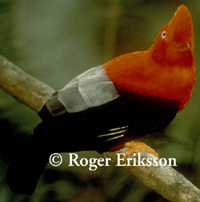 The bird for which the lodge is famous is the Cock of the Rock --
a big cotinga whose male version has a brilliant red head. A photo
appears on the right. During
the breeding season a group of males get together at certain
places in the forest called "leks" where they compete for the
attention of the females. Apparently the leks are in the same
locations year after year, and three or four such places were
known on the Cusco-Manu road.
The bird for which the lodge is famous is the Cock of the Rock --
a big cotinga whose male version has a brilliant red head. A photo
appears on the right. During
the breeding season a group of males get together at certain
places in the forest called "leks" where they compete for the
attention of the females. Apparently the leks are in the same
locations year after year, and three or four such places were
known on the Cusco-Manu road.
For the benefit of the bird-watching tourists, blinds had been built next to at least two of them, one of which was only a couple of hundred meters from our lodge. The males arrive to put on their show between about 5:45 and 6:30 am, and the first morning we were there, Wily took me and John and Ellyn to the blind to see what we could see. It was near the end of the breeding season so we were not confident that we'd see anything.
We got there at about 5:30 and sat in silence until after 6:30 and saw only a toucan and some woodcreeper -- no lek action. Almost as soon as we walked out of the blind, however, Wily spotted a male in the trees. He wasn't competing for females, but was still quite impressive. Over the course of the next couple of weeks we saw quite a few of them (I only saw males).
I think that since the lodge is known for these birds and consequently there are photos of them on the walls we weren't as impressed by them as we should have been. Toward the end of the trip I asked a bunch of folks to name their favorite bird or birds of the trip, and the Cock of the Rock wasn't even mentioned!
If you're looking for birds and there's a male Cock of the Rock around,
it's hard to miss him -- the brilliant red head instantly gives him
away. But I had a pretty interesting experience that made the bird
seem a lot more impressive. I was hurrying along a trail in the
forest concentrating mostly on my footing, and suddenly a Cock of
the Rock flew by only a few meters in front of me. It appeared to
be an enormous bird and the brilliant red flashes had me convinced
for a second that it was a big macaw or something. I just remember
saying to myself "Holy shit!!!". I was actually a little surprised
when it landed to see that it was "just" a Cock of the Rock.
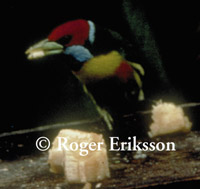 But there was one bird there that impressed me more than the Cock of
the Rock -- the Versicolored Barbet. In the open area outside the
dining room were a couple of feeders where we'd leave bananas to
attract various fruit-eaters -- mostly tanagers. But one day
a little barbet showed up whose coloration was almost hallucinogenic.
There is no guidebook for the birds of Peru, so we were using the
guide for Colombian birds, and the barbet wasn't pictured there.
I couldn't believe that such a bird existed, and what really blew
my mind was that it was only the female. The male arrived a bit
later, and made the female seem dull by comparison.
But there was one bird there that impressed me more than the Cock of
the Rock -- the Versicolored Barbet. In the open area outside the
dining room were a couple of feeders where we'd leave bananas to
attract various fruit-eaters -- mostly tanagers. But one day
a little barbet showed up whose coloration was almost hallucinogenic.
There is no guidebook for the birds of Peru, so we were using the
guide for Colombian birds, and the barbet wasn't pictured there.
I couldn't believe that such a bird existed, and what really blew
my mind was that it was only the female. The male arrived a bit
later, and made the female seem dull by comparison.
I didn't get photos of either the Barbet of the Cock of the Rock, but
luckily a man named Roger Eriksson did when he was visiting the same
lodge on a birding trip with Muriel about a year earlier. Thanks to
Muriel and Roger, I now have photos of both these birds. The one of
the barbet isn't great -- it was originally on video, so the original
resolution is low. But now that I am writing this in the year 2000, I
can declare that the Versicolored Barbet was, for me, the "bird of the
millenium" for the years 1000-1999.
 It may have been due to pure, blind luck, but somehow one of the
non-earthwatch guests at the lodge learned where a Lyre-tailed
Nightjar could be seen. This is one of the most unusual birds in
the world -- its body is like that of a regular nightjar (or nighthawk,
or goatsucker, or poorwill, or whippoorwill), but it has a tail
composed of two extremely long feathers -- perhaps 70 cm long. When
it flies, it looks like a lyre flying through the air.
It may have been due to pure, blind luck, but somehow one of the
non-earthwatch guests at the lodge learned where a Lyre-tailed
Nightjar could be seen. This is one of the most unusual birds in
the world -- its body is like that of a regular nightjar (or nighthawk,
or goatsucker, or poorwill, or whippoorwill), but it has a tail
composed of two extremely long feathers -- perhaps 70 cm long. When
it flies, it looks like a lyre flying through the air.
The photo on the left shows one. Unfortunately, there wasn't enough light for a good photo, so it's pretty dark, but you can see the first part of the giant tail feathers.
For some reason, the nightjar appeared on a stump at almost exactly the same time every evening, and would fly from that stump for 10 or fifteen minutes every evening hawking insects. Then it would disappear. It began to hunt at about 6 pm, just about nightfall, so it was hard to get a very good look, and mostly what we saw was its silhouette against the darkening sky. But if you shined a flashlight at it, the eyes lit up like yellowish torches.
In any case, for the next four or five evenings, a troop of us hiked up to take a look and it was there like clockwork until the unfortunate incident.
We had set up the mist nets along the road, and one morning on the first net pass, we found the nightjar tangled up in the net near where we had seen it hawking bugs. We untangled it without incident, and it flew away, but after that it was apparently smart enough to avoid the area near the net and we never saw it again.
There were quite a few other nightjar-like birds at the site, and we saw them regularly. In fact, one actually flew through the dining room one morning.
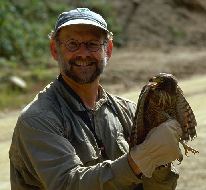 The most exciting thing for me was the Roadside Hawk, as described in
the first paragraphs of this article. I was with Chris, but was
determined to untangle it myself. He asked me, "Have you ever done
this?" -- "Nope." -- "Do you have any idea how you're going to do
it?" -- "Nope."
The most exciting thing for me was the Roadside Hawk, as described in
the first paragraphs of this article. I was with Chris, but was
determined to untangle it myself. He asked me, "Have you ever done
this?" -- "Nope." -- "Do you have any idea how you're going to do
it?" -- "Nope."
I was afraid of the beak, but having talked to experts later, I should have been much more concerned with the talons. If you think about all the nature shows you've seen on the "Discovery Channel", when a hawk is taking prey, it always slams into it talons-first -- the beak is only used to pluck it and eat it.
But I was lucky, and didn't get hurt. I put on some leather gloves that I'd brought in case I had to deal with any bats in the net, and grabbed it from behind. Since the bird is so big compared to the mesh of the net, it was no problem to get the wings untangled, and, continuing to hold the bird from behind, I was able to tug on the net and free the talons without getting my fingers anywhere near them.
Of course I had Chris snap a few photos to document the event ...
Since then, I've learned that a common technique used on hawks is to stick their heads into a can (the can holding Pringle's potato chips is the ideal size for most hawks) and since it's dark, the hawk figures it's nighttime, and sort of goes to sleep. Then getting it out is pretty easy. I guess the hoods that the falconers use serves much the same purpose.
But the next night we were sitting around the table talking about the owl again, and an argument developed about what the sound had been. Somebody made a sound, and that wasn't right, so somebody else tried, and I was positive that was wrong, too.
I said, "It was like this: 'ohhhh, ohhhh, ohhhh, ...'", and I made my best attempt at the sound. I was proven right when the owl not only answered the call, but flew in to give us a beautiful view.
 Every day we were treated to a visit from the monkeys. There
were various species there (we saw howler monkeys fairly regularly,
for example), but the monkeys shown in the photo on the left are
Brown-faced Capuchins.
Every day we were treated to a visit from the monkeys. There
were various species there (we saw howler monkeys fairly regularly,
for example), but the monkeys shown in the photo on the left are
Brown-faced Capuchins.
They were fearless, and came to the lodge at every mealtime, demanding to be fed. Of course, they got bananas every time, so nothing was done to discourage them.
Monkeys weren't the only animals that were acustomed to eating at the lodge -- while we were there, we also had a "pet" coatimundi named "Pinky". Pinky also came for the banana handouts, which he got because he was so cute -- he was a baby. But he was also very obnoxious, and entered our rooms whenever he could to go through our stuff looking for food.
There was quite a battle one day for dominance between Pinky and
the monkeys. Pinky climbed into the monkeys' tree to try to
drive them away, and it was quite a battle. Pinky was far bigger
and probably more dangerous than an individual monkey, but there
were lots of monkeys, and they teamed up against Pinky. They
kept their distance, but they'd try to shake the branches he was
on so he'd fall out of the tree. Pinky was far more clumsy than
the monkeys, but he was able to hang on. On the other hand, he
was never able to catch a monkey, so the whole contest basically
turned out to be a draw, but there was a lot of noise in the
meantime.
It was pretty eerie, walking down the road, with the sky overcast and even a little rain, so we couldn't even see stars. With our imaginations running wild, you get a pretty good dose of adrenalin when you point your flashlight down the road and see a couple of pairs of "demon eyes" staring back at you. When we got closer, we discovered that they were just a group of goats.
I did take some photos, both of the frogs we found (most of them were tiny), and of some random insects that we found. If you're interested, here are some relatively unedited photos of the frogs. The images are big, so it'll take a while to load them unless you've got a relatively fast connection.
Then you repeatedly discard a card to your right, and as soon as you've done that you can pick up the card that the person on your left discarded to you. As soon as anybody gets a set of four matching cards, he/she grabs for a spoon. As soon as anyone reaches for a spoon, everyone reaches for a spoon, and the person who doesn't get a spoon gets a letter of the word "spoons" instead. As soon as you get all six letters, you lose.
With five people simultaneously diving for spoons, it's easy to break a finger, or fall out of your chair, or even knock the table over if you're agressive enough. All of the above happened, and luckily we were playing "spoons" instead of "forks", or worse, "knives".
At the lodge we had our coca tea in tea bags, but when we got back to Cusco, we could get it made from fresh coca leaves. The tea with the fresh leaves tasted great, but, as far as I could tell, had approximately the same effect of the other -- nothing.
I said, "That's nice, but have you ever gotten a photo of yourself, naked, on the cover of an academic journal? I have."
At one point in my career as an engineer, a couple of friends and I had produced a image beginning with a photo of ourselves sitting naked at computer terminals, but with the strategic parts covered with the red international "no" symbol, and with the text underneath, "No Skinnyhacking".
It was quite popular when we first made it, but interest waned, until a few years later when a friend was writing an article for the computer graphics publication for SIGGRAPH (Special Interest Group in Graphics) that concerned hardware/software to project images onto scenes. He said he needed an image to use in the article, and did I have any good ideas?
I showed him the "No Skinnyhacking" image, and he said he wanted something less controversial. I said not to worry -- I knew the editor of the journal that year, and that he would accept or reject the article purely on technical grounds, and at the worst, he'd ask them to remake the illustration with another projected image.
So the article was submitted for publication with the skinnyhacking image, it was accepted, and a couple of months before it was to come out, my friend got a call for the journal editor. He figured it was probably the "please change the image" call, but in fact, the call was to tell him what a cool image it was, and could they put it on the cover of the journal?
They could, and it was, and as a result I "raised the bar" for Doug slightly above his previous best of "chubby". But who knows? I expect great things from Doug in the future, and I wish him the best of luck in outdoing the skinnyhacking image.
One photo I would love to have is of the church. When the conquistadores arrived, they tore down the Inca temples and usually built their own churches on top of the ruins. The photo I wanted was of such a church -- nearly in ruins, with walls falling apart, cracks, and gaping holes, but the foundation of Inca stonework looked almost as good as it probably had on the day the Incas finished it. Throughout town there were a number of old Inca walls standing, always in fantastic condition.
At the top of one of the passes we hopped out of the bus to look for a couple of high-altitude hummingbirds, and on the highest, after we hopped out, the bus went ahead, "around the corner" to a better parking place. Well, "around the corner" was a long way, and so we did a fairly long hike. At least it sure seemed long, because we were at about 4100 meters elevation. It's amazing how soon you get winded hiking around.
I also think this was why Ellyn had bad headaches that night. Coming in, she'd done OK. Although we were only in Cusco for a couple of hours, we did spend many more hours at very high elevation, but riding a bus. Coming back, it should have been easier, since we were now acclimatitized to about 1800 meters for two weeks, but she came down with a roaring high-altitude headache, and it didn't go away until we got down to Lima.
We had a going-away dinner in Cusco (where Ellyn didn't eat much), and unfortunately it was in a tourist-oriented restaurant so I was unable to order "Cuy" (guinea pig). But the "Pisco Sours" and the beer were good.
The flight home was long and the only problem we had is when we arrived in San Francisco to discover that one of our bags had been ripped open. All the locks were broken, but nothing appeared to be missing, although the contents were soaking wet. We knew from this that the bags had been opened in San Jose, Costa Rica, since we had to change planes there, and that was the only place it was raining during the trip home.
Brilliant Hummingbird
Booted Racket-tail Hummingbird
Dragonfly (taken on night hike?)
Lyle-tailed Nightjar
Brown Capuchin Monkey
Motmot
Motmot (in the hand of the author)
Sicklebill Hummingbird in the net
Speckled Hummingbird
Long-tailed sylph (1)
Long-tailed sylph (2)
Want to send me mail? Click here: tomrdavis@earthlink.net.
Return to my home page.